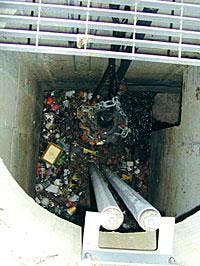Pilot Plant Helps City Limit Combined Sewer Overflows
By Carl Dorsch
If you go looking for a particular wastewater treatment plant in Cincinnati, OH, the first thing you'll notice isellipse you might not notice it at all. In fact, when following perfectly clear directions to the facility, you might still drive right by it, dismissing it as just another office building. It doesn't register as a treatment plant.
And that was one of the goals for this state-of-the-art pilot project recently built in a western suburb of Cincinnati. Officially known as the Muddy Creek-Westbourne High Rate Treatment Facility, it was placed into operation in June 2001 by the Metropolitan Sewer District of Greater Cincinnati (MSD). An unmanned satellite plant, it is set up to automatically handle high volume, wet weather sewage flow. Developed with the consulting firm of BBS Corp. of Columbus, it was designed to blend seamlessly into the surrounding neighborhood.
"That was the intention," said Don Cuthbert, Vice-President of BBS. "You don't see it, you don't smell it, and it just sits there, quietly cleaning up the creek.
"In designing it, the main concerns were public health and water quality. But from a community perspective, I think they're more interested in aesthetics, odors, and overall appearance."
Alleviating CSOs
Like many cities, Cincinnati is attempting to find the best ways to meet state and federal requirements concerning Combined Sewer Overflows (CSOs). Efforts to reduce or eliminate CSOs generally focus on three solutions. The most expensive is to separate the sewer flows. Typically this is done by building a new sanitary sewer, and using the existing combined sewer as a storm sewer. A second, and a more limited course of action, is to increase the ability of the treatment plants to receive high rate flows.
A third solution is to develop storage capacity within the system, so as to equalize the flow to the treatment facility. This can be done with in-pipe storage. Some cities have built large tunnels to capture and hold sewage for later treatment. Others have used vortex regulators to restrict and back up the flow in existing sewers.
An alternative method to in-pipe storage is to divert high rate flows to satellite tanks, that fill and then empty into interceptor lines running to the main treatment plant. This is the method employed by MSD at its pilot project.
One of the advantages of building satellite tanks is the latitude afforded in site selection. Since the facility was the first of a possible 10 to 30 plants the district may build, not only could staff choose where to locate near a particular CSO, but they also had several CSOs to select from.
Marty Umberg, MSD's Chief Engineer, said the selection was guided by a desire to make an impact on an urban stream. "We were looking at implementing facilities of this sort first in suburban type areas; where we can make impacts and real improvements to the streams."
The site selected for this first facility was at the origin of the Muddy Creek, which winds its way to the Ohio River. In dry weather, the Muddy Creek barely exists.
At this location, a trunk sewer passes by, carrying the combined storm and sanitary flow from a suburban drainage basin of roughly 2,000 acres. Before the pilot plant went into operation, whenever it rained the storm water would pour into the trunk line until the interceptor was full, and then the combined flow would divert into the Muddy Creek. The creek would then receive all the debris swept into the storm sewers, not to mention the contents of the sanitary flow.
Diversion, Detention
Built on a property of about an acre and a half, at a construction cost of a little over $5 million, the satellite plant separates the flow from the trunk line at a diversion chamber and runs it through a coarse screen and over a grit pit.
The flow is then channeled to a regulator, which in dry weather allows it to move downstream to a wastewater treatment plant. In a rainfall event, as the flow rate increases, the regulator diverts the flow to a detention tank. The tank, which is below ground, is approximately 200 feet long by 90 feet wide. The bottom of the tank slopes from a depth of 19 feet down to 26 feet, allowing it to hold a maximum of 1.7 million gallons.
After the high-rate flow subsides, sensors trigger the pumping of sewage out of the tank to the underflow line and main treatment plant. As the detention tank empties out, sensors open up, in sequence, a series of six five-foot high flush basins that clean out all the sludge and debris that accumulates along the tank's bottom. At that stage, the system is ready for the next rainfall event.
For most events exceeding the tank's capacity, it still serves to settle out the solids. The treated flow is chlorinated and dechlorinated, then overflowed through fine screens and sent off to the Muddy Creek.
During a prolonged heavy event, the regulator will permit the flow to by-pass the tank, sending it through fine screening and then to the creek. Finally, in the heaviest of all events, the initial diversion chamber will overflow directly to the creek, with the flow receiving only coarse screening.
"The facility can treat about 79 cubic feet per second, maximum rate," Cuthbert said. "Most of the events it'll see in a year have fairly low rates. There won't be many hours in excess of what we can treat through the facility."
"Before the facility was put on line, we'd typically have 130 rainfall events, with nearly 600 hours of rainfall. Overflows would occur nearly 50 times per year, for about 260 hours in an average year."
"With this facility on-line, we're now in a treatment mode for about 200 hours per year; and in a bypass mode through a secondary screen for about 16 events, and about 100 hours per year. The point is, we're trying to intercept and treat at least 85 percent of the annual wet weather flow. That's the goal we're shooting for, and I think it'll turn out to be quite a bit more than that."
Chop It, Pump It
Because of the debris entering the plant, the job of emptying the detention tank relies on a pair of chopper pumps purchased from the Vaughan Company.
"When the tank empties out, it's quite impressive what's on the bottom. After a normal event, there's like four inches of sludge built up on the bottom," said Lou LaCortiglia, MSD's project manager for the plant. "Mixed in with the sludge are papers, leaves, beer cans, plastic bottlesellipse a lot of junk. And it all has to go through the chopper pumps."
Two 25 hp chopper pumps (800 gpm) are used to empty the tank, and a smaller 15 hp Vaughan chopper pump (300 gpm) is used to chew through the debris raked from the fine screens and sent to the screenings sump.
"That might be the bigger challenge for a pump," LaCortiglia said. "It's unbelievable how many cigarette butts can end up in there."
About the Author
Carl Dorsch is a mechanical design engineer, now doing freelance technical writing


